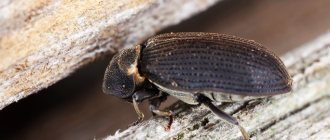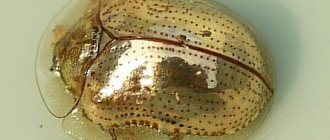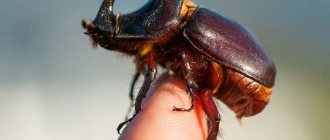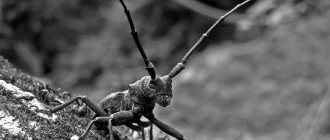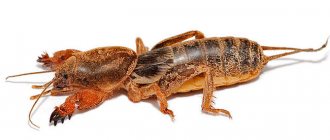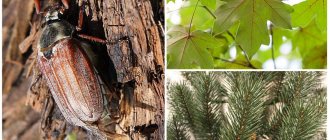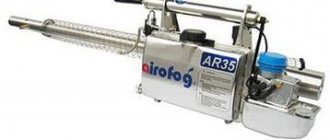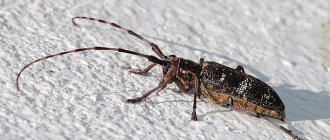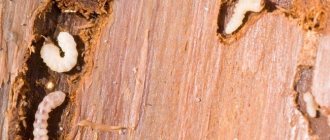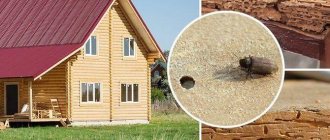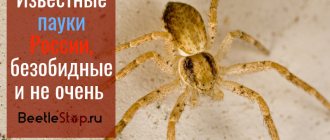Methods to combat bugs
If black beetles appear in the apartment, then first you should determine their type based on external signs.
Depending on the identification, you can use various control methods to help get rid of black beetles:
- Carpet beetles and carpet pests should be combated by treating carpets and furniture; first they must be wiped with a sponge soaked in a soap solution, and then with a vinegar solution; a day after treatment, carpets and furniture should be vacuumed well, and the contents of the bag should be thrown away, as there may be insect eggs in there;
- to destroy flour beetles, it is necessary to carefully sort through all reserves of bulk products (flour, cereals, sugar, etc.); if they are found, everything must be thrown away, because they are not suitable for consumption;
- inspect the contents of all cabinets for small black or red bugs, then make a solution of 1 tbsp. l. soda per 1 liter of water and treat all surfaces and shelves inside the cabinets, wash the dishes using detergents and pour boiling water over them;
- wash all surfaces in the kitchen with a solution of acetic acid or use boric acid powder, which should be rubbed into areas where parasites may live;
- treat the floor covering and baseboards with any aerosol containing an insecticide against insects (Dichlorvos, Combat, Raid, etc.);
- clothes should be boiled or washed in hot water (not lower than 60°C).
If the measures taken do not help or there is no time to fight bugs in the apartment for a long time, then it is better to turn to professionals. There are companies that use special preparations to carry out disinfestation (extermination of pests) in any residential premises.
Fighting bugs in the house
Fleas: danger, biology, specifics of control
Fleas are another biting parasitic insect in the apartment. They spend most of their time in shelters near the resting places of domestic animals, often spending a long time in the fur of cats and dogs. The larvae of these small blood-sucking insects can be found in any place where there are rotting organic remains: in garbage, sewers, animal bedding.
Adult fleas feed exclusively on the blood of humans and animals. But their larvae can eat both food products and the excrement of adult fleas or pets.
All the difficulties of fighting fleas are related to the fact that they can be found both in the fur of animals and anywhere in the room. Of all the insects that live in an apartment, fleas require the most comprehensive approach when removing them: they are first destroyed on animals, then indoors, and finally the surviving larvae are poisoned.
White insects in the apartment - who are they?
While recognizing cockroaches and ants is not difficult, the appearance of strange little bugs causes serious difficulties, since in order to eliminate parasites, one must know their exact type.
Let's try to figure out who can start up in the house.
- The most common type of parasitic white insects in an apartment is silverfish (in common parlance - woodlice). It is a small wingless individual, an oblong body with numerous legs. In fact, the body of the parasite is not completely white, it is rather silver, but in sunlight it appears almost transparent. Such insects feed on starch and products containing it. Due to the fact that silverfish choose damp places, the main area where the insects will be located will be the bathroom or kitchen, especially the sink area.
- The sugar silverfish can be designated as a separate species; it most often appears in food warehouses, kitchen drawers with food, and libraries (since it loves book bindings and glued pages). Such insects come out only in the dark, so it is quite difficult to detect them.
- White midges most often appear on indoor plants; this insect is called a whitefly. It is almost impossible to prevent its occurrence, but it is very easy to escape from it - just treat the soil and affected leaves with a weak solution of manganese, repeating the procedure if necessary.
- Light-colored bugs in kitchen cabinets can be food midges; they feed on cereals and other bulk products, spread very quickly, and in a few days the pest population can increase several times. These insects can appear in an apartment due to improper sanitary conditions - high levels of humidity, the presence of crumbs and other debris. Having appeared in one product, after a couple of hours the midges will move to other places, and they actively infect even hermetically sealed products.
Of course, there are other representatives of parasitic insects that can occur in an apartment; each species has its own means of control, but if you cannot determine the exact type of pest, use complex preparations that help get rid of any apartment parasites.
What are the different types of kitchen pests?
Types of bugs that live in the apartment
The bugs that attack supplies in the apartment are generally similar to each other. They are all small, their colors range from red to dark brown and black. Taste preferences differ slightly: some love flour and small cereals, while others will not refuse beans, cookies and even wood.
There are a lot of insects living in apartments. The most common among them are:
- Red flour eater. Tiny bugs, not exceeding 2 mm in length. They are light brown or red in color and have hard wings. Their small white larvae are almost invisible in dry bulk products. Cereals and flour where such pests have appeared must be thrown away.
- Flour beetle. The bugs are brown in color, with antennae 2-3 mm long. The foods they eat clump into clumps.
- Bread grinder. Especially voracious brown insects that live in kitchen apartments are covered with shaggy hairs. Their body is no more than 4 mm in length.
- Food moth. Adult representatives of these small insects in the kitchen reach a length of 1 cm. Most often they settle in pasta, cocoa, tea, and do not refuse to eat dried fruits.
- Granary weevil. The beetles are dark brown in color with defective wings. They grow no more than 4 mm in length. On the front of their head they have a protrusion that resembles a long proboscis.
- Grains. Black insects with yellowish legs and antennae. They have spots on the back and elytra.
- House ants. Unlike forest ones, these are very small brown ants in the apartment.
- Common silverfish. In everyday life it is called a sugar bowl; this insect has a flat body, tapering towards the end.
Whatever type of pest is found in the dining room, it must be dealt with. The longer you ignore the appearance of insects in your apartment, the more they will multiply, spoil more food, and the more difficult it will be to destroy them. Therefore, having met one representative of this species, it is necessary, without delaying until tomorrow, to take decisive action.
Favorite habitat of insects
Insects in the kitchen love to live in cereals and flour
Kitchen pests thrive in temperatures between 15°C and 30°C.
The red flour eater likes flour and small cereals, such as semolina, corn, wheat, and barley. He also does not refuse rice, buckwheat, cookies, crackers, and compote mixture. The flour beetle loves to live in flour or starch. As they multiply, the insects take over new territories and move into other finely ground grains.
The bread grinder prefers loose leaf tea, instant coffee, beans, peas, nuts, and tobacco as food. Besides food, he loves wood from kitchen cabinets and book pages.
Granary weevils most often attack rice, wheat, barley, and rye. Much less often, insects in the kitchen settle in corn, buckwheat, flour or pasta.
Caryopsis attacks legumes: peas, beans, beans.
Sugar silverfish live in dark, warm, damp places. The bathroom is well suited for this. She feeds on sugar, flour, glue, and wet paper.
Pet food bags are also suitable habitats for most kitchen pests, so they should be tightly sealed and kept in a cool, dry place.
Damage caused by bugs and danger to human health
Indoor insects lay larvae and leave excrement in the food in which they live. If all this gets into the human digestive tract, he will become poisoned. Therefore, if you find at least one pest in a container with cereals, all its contents must be thrown away. To think that a single guest wandered here by chance is a big misconception. While the adult kitchen parasite is difficult to see, its white or transparent larvae are even more difficult to discern with the naked eye.
Methods for getting rid of black bugs in the kitchen
If you find bugs in the kitchen, take the necessary measures to destroy them:
- Identify and correct the source of the problem. Empty the cabinets and review all supplies of cereals, flour, dried fruits, tablets, tea and coffee. Place spoiled food in a bag and place it in the trash.
- Inspect the kitchen furniture, window sill and household appliances - sometimes uninvited guests are found in such unusual places.
- Wash food storage containers with soda solution.
- Wipe the doors and shelves of cabinets in the kitchen with a cloth soaked in a solution of vinegar (1 tablespoon per 1 liter of water) or detergent.
- Seal or seal any cracks that are discovered during cleaning.
- Pack the remaining intact cereals in an airtight glass container and take them outside the kitchen for 10-14 days. If no insects appear in them during this time, they can be eaten.
Products that could be contaminated with parasites are subject to special treatment. The following methods are used for this purpose:
- exposure to ultraviolet radiation;
- exposure at high temperatures in the oven (10 minutes at a temperature of +100…120 ℃);
- exposure to low temperatures during the day (in the freezer).
Folk ways to fight bugs
To combat bugs in the kitchen, products with a bright aroma are used. Pests are repelled by the smell of bay leaves, lavender, garlic, wormwood, borax, vinegar and nutmeg. To get rid of pests, place any of them on the shelves of the closet and do not forget to change them periodically.
Traps that you can make at home will help you get rid of pests:
- Combine borax and powdered sugar in equal proportions.
- Pour the mixture into the lid and place the trap near the pest habitat.
- Check the bait regularly and refill it if necessary.
Chemicals in pest control
When folk remedies do not help cope with pests, perform chemical treatment of the room. The method is used in exceptional cases with large-scale damage.
Treating cabinets with chlorine-containing products (Domestos, Belizna, etc.) will help you deal with bugs in the kitchen. Wipe all shelves, walls, cabinet doors and leave the room to ventilate for a couple of hours. After a day, repeat the treatment.
Other means to combat bugs in cereals and in the kitchen:
pyrethrum powder. Sprinkle the product where you store food and after a couple of days you will forget about pests. The insecticide is safe for pets and people; "Lovin Fire Protection". An effective poison for flour eaters and bread grinders. When using the product, wear a respirator, as its fumes are dangerous to humans; "Anti-bug." Treat wooden surfaces with a special protective agent - it will not only get rid of pests, but also prevent their appearance in the future
Be careful when working with the product, as it is dangerous if it comes into contact with the skin or mucous membranes; "Rogneda". The drugs of this brand are effective in combating various pests - bugs, ants, flies, fruit flies, cockroaches. According to consumer reviews, proven Dichlorvos will help remove bugs forever
Procedure for using the aerosol:
According to consumer reviews, proven Dichlorvos will help remove bugs forever. Procedure for using the aerosol:
- Hide all food products and throw away spoiled products.
- Wash cereal containers and all kitchen cabinets.
- Make sure there are no pets or children in the room. Take personal safety measures - wear a respirator or bandage.
- Spray the room with an aerosol and close the kitchen for half an hour. Then turn on the hood and open the window to ventilate the apartment well.
Prevention in cabinets
Small bugs in the kitchen are very tenacious creatures.
Even “super housewives” are not immune from them. Small bugs in the apartment do not appear due to lack of hygiene. Pests can be introduced by purchasing already contaminated products. When choosing pasta, flour, cereals, you need to carefully examine the packaging, check its integrity and expiration date. You should not purchase bulk products with strange impurities. It is not recommended to purchase cereals by weight or from unknown manufacturers. It is better to give preference to trusted companies that use high-quality packaging.
Make yourself a rule: immediately after purchasing, place the cereal in the freezer for a couple of days.
Following these simple rules will help reduce the risk of unpleasant guests appearing in the kitchen:
- Keep nuts and dried fruits in the refrigerator, cereals in hermetically sealed containers (transparent containers).
- For storage, you can use cloth bags boiled in a strong saline solution. Cool the bags without removing them from the solution, then dry and iron with a hot iron.
- Inspect regularly and throw away expired goods.
- Monitor food storage conditions. High humidity and temperature are a favorable environment for the appearance of bugs.
- Regularly carry out wet treatment of high-risk areas using a mixture of bleach and levomycetin (half a bottle of Belizna and 20 tablets of medicine are needed per bucket of water).
- Place the borax on the shelves.
- Arrange open matchboxes. Beetles do not tolerate the smell of sulfur, so the boxes can be installed on the cereals themselves.
- Coat cracks and crevices in cabinets, floors, and window sills.
What do kravchiki look like?
Body size varies from 2 to 3.5 cm. Males are larger than females. A characteristic feature is a large head with large jaws. Males have additional fangs. Males use them when fighting with an enemy or competitor during the mating season.
The large head smoothly blends into the chest. The abdomen is convex, making up 1/3 of the whole body. There are no wings, snow beetles live underground and crawl on the surface. The body is covered with a durable chitinous covering. The color is coal black or with a blue tint. The legs are short, strong, ending in claws. A photo of the imago is presented below.
Mucoeds
They are polyphagous beetles, that is, their menu is very diverse. Three types can be found in apartments.
Surinamese
A beetle 3-3.5 mm long with a red-brown back. The pest is flat, very elongated in length, with a thin body. The pronotum has characteristic longitudinal “ribs”.
Prefers bakeries as a bottomless source of nutrition. But often, along with flour and cereals, it gets into apartments, where it infects other supplies. The vital activity of bugs leads to an increase in humidity in products, which is why mold forms in cereals.
Maximum lifespan 3 years. Usual 6-10 months. The life cycle is 27-51 days at a temperature of 29-35°C.
Red mukoed
The light brown beetle is approximately 2 times smaller than its Surinamese “brother”. In the apartment, the food supply, habitats and life cycle are similar to those of the Suriname mucoedeater. A distinctive feature of the red mucous eater is inactivity.
Mucoeds
Merchant beetle
A flat small beetle, 2.5 cm long. Almost completely identical to the Surinamese beetle in morphology and lifestyle, differing in eye size and head shape. The bugs crawl actively, moving to new habitats.
White bugs
Small white insects in the apartment can also bother residents. They appear in the house due to dampness and lack of proper cleanliness. It is possible for them to enter the home through unclosed doorways or windows, holes in risers and walls.
It is not difficult to recognize ants or cockroaches, which is impossible to say about small bugs of unknown origin. To get rid of parasitic individuals, you need to know what they look like.
The most famous insect that lives in apartments is the silverfish, or woodlice. The wingless variety with an oblong body has numerous legs. The silvery surface of the bug appears transparent in sunlight. The food for this is starch and products containing it. Due to its damp habitation, it is not difficult to find in bathrooms or kitchen sink areas.
Because they live on book bindings and glued pages, they are called “book louse.” The sugar variety of pests is found in food boxes, food storage warehouses, and libraries. They are difficult to notice because they appear on the surface after dark.
Whiteflies live on indoor plants. Rescue from the bug is caused by treating the affected leaves and soil with a weak solution of manganese. White bugs in pieces of furniture in the kitchen are food midges that eat bulk foods. They are characterized by rapid reproduction. The cause is premises without proper sanitary treatment. Such an area is an ideal habitat for them.
Their settlement is facilitated by excessive humidity, uncollected crumbs and other debris. Insects can infest one type of product and easily move to neighboring food, vigorously attacking hermetically sealed objects.
To combat this, agents and chemicals that do not pose a risk to human health are effective. Comprehensive pest control leads to the desired result. It is necessary to free the room from traces of cobwebs, dust and all kinds of contaminants, followed by disinfection with chlorine-containing substances from a series of household preparations.
After the surfaces have dried, hidden holes and corners are wiped with copper sulfate. Heat fans or hair dryers are most effective. At the final stage, the rooms are cleaned with the addition of vinegar water. Magazines and books are checked for insect eggs being laid in them. The shelves should be sprayed with water with the addition of lemon or intensively blown with a vacuum cleaner.
Home thermobia
In living spaces, unpleasant-looking insects called silverfish often appear and settle for a long period of time. The bugs have no wings. An oblong body with a small head with antennae and three tails in the form of processes causes outright hostility among people. They get stuck in the darkened holes in the corners. Home thermobia settles in the bathrooms of apartments and country houses, causing damage to objects and coatings.
The aerosol products produced by the current industry are suitable for exterminating all types of household pests. Useful drugs are intended as effective protection or preventive measures.
Small insects are not uncommon in the apartment. And it's not just fleas and cockroaches
But, taking certain precautions and following the clear instructions in the instructions when fighting all kinds of bugs, it is possible to achieve the desired effect, and no worms will appear in the apartment. Remember that only the owner will cope with the problem who treats the problem with full responsibility
Appearance Features
The order of arachnids received its name because of its unusual pedipalps, which end in claws, like those of a scorpion or crayfish. In total, 3,300 species of pseudoscorpions are known. They live in tropical countries and continents with cold climates. They live in caves, high in the mountains, and holes in the ground. There is only one species found in a person’s home – Chelifer cancroides. Found in books and dusty rooms.
- The book false scorpion looks like a house tick. The body is flattened, miniature, with a dense chitinous cover. The adult size is 3 mm.
- In front is a small cephalothorax with two claws - modified pedipalps. The beetle, similar to a crayfish, uses its “weapon” to capture prey, grind it, and crush the integument. The length of the claws is equal to half the small body of the beetle.
- Colors in brown tones - dark, light. Sometimes the beetle is perceived as black. The abdomen has even stripes.
- 4 pairs of legs are attached to the cephalothorax. Short but strong. They end in claws. The pseudoscorpion moves slowly, often sideways, but can walk forward and backward.
A photo of an insect similar to a scorpion is located below. Females are slightly larger than males. The larvae are initially born white, then the chitinous cover darkens, and after the first molt it becomes denser.
Who are these bugs and where do they come from?
Brown or black small bugs in the apartment are skin beetles. Insects enter the room through windows, cracks in the wall, floor, and ventilation hatches. Frequent infestation of apartments by beetles is observed in multi-storey buildings. In addition, the skin beetle can get into the house on clothes, hair, and shoes.
Carpet beetles are considered the most dangerous enemies of museums, archives, libraries, and paper storage facilities. Cause significant damage to natural fabrics, carpets, fur and leather products. The life cycle of an insect includes:
- Egg
- Larva 5 instars;
- chrysalis;
- Imago.
The body shape of an adult insect is oval and does not exceed 5 mm. The color is brown or black. The adult lives less than the larva at all stages. The female chooses places with a pile or rough surface for laying eggs. These can be carpets, fabric, fur, wool, folds of products. The breeding season lasts from April to June. Carpet beetles love bright light, so in an infested room they can often be found on window sills or in lampshades. The fertilized female lays eggs in batches over 2-10 days. In 10 days, the maximum number of eggs is 100 pieces. After completing the breeding mission, the bugs die. The eggs are oblong, white and very small - about 2 mm. The duration of embryo development directly depends on the ambient temperature. Can last from 2 to 55 days.
There are several types of domestic skin beetles. Some people prefer to live in the living room, bedroom, or office. Others make their way into the kitchen and food storage area. The larvae are especially dangerous. An adult beetle can feed on plant sap or do without food at all. A characteristic feature of all leather beetles is that they love dry conditions. The bathroom and toilet do not attract them. The brown bug moves little and turns over with its paws up when touched. Freezes when in danger. After laying eggs, adult beetles die.
Types of skin beetles and their description
Carpet beetles are small bugs; individuals with a body length of up to 5 mm and a width of about 0.5-1 mm are more common. They have an oval shape, less often they are found with a round or elongated body. There are many types of such insects.
The most common are:
- Ham skin beetle. Found throughout the Eurasian continent. It can appear at home, that is, in residential premises, and in warehouses. These are oblong black bugs. There are gray spots on the upper part of the wings, but it is quite difficult to distinguish them with the naked eye. The larvae of this insect are dangerous. Before pupation, they bite into surrounding materials, and this can be textiles, wood, books and even telephone cables.
- Carpet beetles are a name that combines several types of dark brown carpet beetles. Larvae are also dangerous here. Very often they damage products made of fur and wool, although theoretically they can even feed on particles of house dust that contain organic debris - the same hairs from the carpet. Moreover, only the larvae feed, and adult beetles only constantly consume the nutritional reserves accumulated in the previous period. These are flying bugs. They are found not only in apartments, but also in wildlife, and in natural conditions they settle in tree hollows and bird nests.
- The Smirnov's carpet beetle is a relatively recently introduced species of insect in Russia. It is believed that it was introduced into the country about 50 years ago. During this time, he managed to adapt to local conditions. This is the type that can most often be found on the windowsill.
- The fur coat beetle is a black beetle, but it has small white spots on its back - usually five of them. It is not found so often in apartments, so it is considered relatively harmless. But when these pests get into the house, they do not spoil fur products, but eat various products, especially Hercules flakes.
- Museum and house leather beetles are precisely those insects that are quite rare. Although their eggs can be brought into the house with decorative flowers in pots, which are an ideal habitat for them.
- Frisch's carpet beetle is an oval beetle of dark gray or black color. It is found very rarely in homes.
In Russia, domestic species of insects such as the carpet beetle and Smirnov's carpet beetle are more common.
Thus, these insects can feed on skin, fur, wool, meat products and cereals. In the kitchen they eat cheese, powdered milk and even dried and smoked fish. They can also spoil various grain products and ancient books.
Why is a little bug dangerous?
Bugs appeared in the apartment - all the residents lost peace. Unknown creatures create fear; it is unclear what can be expected from them. The damage caused by bugs in an apartment consists of damage to property and food. They can ruin expensive interior items, books, chew carpets, and fur products. The fur coat is especially affected. Sacks, packages, poorly closed jars of cereals, flour, and drawers are being found in the kitchen. They can live in cabinets, bread bins, and on shelves. Of course, the cereal can be cleaned of bugs and larvae removed. But the eggs remain.
The excrement of bugs poses a particular danger to humans. When ingested along with food, they cause allergies. It is difficult to predict the reaction. This may be ordinary redness, a rash on the skin, or attacks of choking, coughing, or signs of poisoning. There is no need to be afraid of bites from small bugs. Human skin is of no interest to them. Although, judging by the name, one might suspect this.
Larvae spoil natural things in the same way as moths. Gnawing holes, cutting off lint. Without seeing an adult bug, you might think that a moth is operating. Control measures are similar, but have their own characteristics.
Signs of defeat
Wood-boring beetles reproduce very quickly. These pests begin to destroy wood at an early age
Therefore, it is very important to promptly notice signs of their presence on the site.
Presence of holes on wooden surfaces. The beetles that live in the house always make small holes or full-fledged passages in the tree. Wood flour often pours out of them. Small larvae can also hide in these passages.
Light weight of building materials
When buying boards for finishing a house or bath, you should pay attention to their weight. If the tree seems too light, this may also be a sign of woodworm damage.
They usually eat the board from the inside.
Unpleasant sound. If there is a beetle in the house, you can recognize it by its characteristic grinding sound. It is heard especially well at night.
Presence of dark spots on the surface. In some cases, brown liquid may ooze from the holes made by woodworms. It has a pungent odor and spoils the appearance of the furniture.
In the evening, these pests can be seen with the naked eye. The easiest time to spot them is during mating season. That's when they leave their shelters. Pests crawl on countertops, window sills, and also fly near lamps. Having noticed such bugs, you need to immediately begin pest control.
Grinders
Furniture
Small brown bugs on a windowsill made of wood may turn out to be furniture grinders that have left their hiding places in the wood. The adult size is 2.7-4.5 mm. The body is cylindrical, elongated. There are 10 clearly visible grooves on the elytra. The body is covered with sparse light bristles.
The adult lives only 6-28 days. As adults, the bugs do not feed; their only goal is to leave offspring. The wood is eaten by larvae, which gnaw holes in it and pupate there.
Brownie
This beetle is unlikely to appear in an apartment, as it prefers frost-damaged wood. But residents of wooden private houses should be wary of it. Compared to other domestic parasites, this is a large insect: 4-7 mm. The color is dark gray with a brown tint. On the sides of the pronotum there are spots of golden bristles.
Weevils and borers
Preventative measures for brown bugs
To eliminate brown bugs, it is necessary to carry out extermination and preventive measures.
Such activities are expected to include:
- Carrying out periodic checks for the presence of brown bugs;
- Constant ventilation, especially in winter, with the temperature in the room dropping to 12 degrees;
- Sealing of residential premises, eliminating cracks and possible entry points for pests;
- periodic wet cleaning of premises using special products.
Good to know! Controlling such pests is quite difficult. This is due to their small size, high vitality and omnivorous nature. However, the use of preventive measures, periodic inspection of possible places where pests accumulate and carrying out all methods of destruction will prevent the settlement and spread of small brown bugs.
Grinders
Furniture
Small brown bugs on a windowsill made of wood may turn out to be furniture grinders that have left their hiding places in the wood.
The adult size is 2.7-4.5 mm. The body is cylindrical, elongated. There are 10 clearly visible grooves on the elytra. The body is covered with sparse light bristles. We suggest you familiarize yourself with the remedy for small house ants
The adult lives only 6-28 days. As adults, the bugs do not feed; their only goal is to leave offspring. The wood is eaten by larvae, which gnaw holes in it and pupate there.
Brownie
This beetle is unlikely to appear in an apartment, as it prefers frost-damaged wood. But residents of wooden private houses should be wary of it. Compared to other domestic parasites, this is a large insect: 4-7 mm. The color is dark gray with a brown tint. On the sides of the pronotum there are spots of golden bristles.
Weevils and borers
How do you get into the apartment?
There are many ways that insects use to get into a person’s home. So you don’t have to wonder where bugs come from in your apartment.
- Housewives bring them from the store along with groceries.
- Bugs that get into the house can be spread by birds. In particular, pigeons. If you feed these birds on the balcony, you can get such an unpleasant living surprise as “gratitude”.
- In high-rise buildings, pests often crawl out of ventilation shafts and cracks near pipelines. This happens if insects have bred in large numbers with neighbors, in the basement or attic.
- From the entrance through the front door, if there is even the slightest crack where this miniature creature can slip through.
- The black flying beetle can take advantage of open windows or a vent if there is no mosquito net.
- Having visited where these insects live, there is a risk of bringing them home on clothes, in hair, or in a bag.
- In summer, they often cling to the fur of animals walking on lawns.
Ways to enter the house
Small black bugs or their brown counterparts can get into the home in one way - they are brought in with food (usually flour or cereals). Initially, pests infest cereals in production, the reason for this is non-compliance with storage conditions or violation of technical conditions during production. Due to poor quality processing of grain during the production of cereals, it becomes infected.
Bread affected by bread grinders
Bugs also appear in the kitchen if you buy a loose product. They can start under the conditions that were discussed above, however, insects move to clean cereals from a nearby uncovered container with loose product.
When the degree of contamination of food with insects is high, it is better to throw away such cereals and not eat them.
If a bug was found in flour, rice, or millet, it means that pests have already been there and probably multiplied. By consuming such a product, a person risks being poisoned, since insect excrement remains in the contaminated cereal. Such food is not beneficial for another reason - there are practically no nutrients left in it.
Types of house beetles and methods of fighting them
To combat beetles, the following measures can be taken:
Carpet beetles, like their eggs and larvae, are afraid of the cold. Low temperatures during their development can be destructive. Therefore, especially in winter, ventilate the house more often; For prevention purposes, insecticidal aerosols can be used. If you do this several times a week for a month, the problem can be completely solved; Clothes are treated with permethrin solution. It does not harm things, but repels both skin beetles and moths; By scattering boric acid in insect habitats in the house, you will get rid of not only bugs, but also other unwanted neighbors; Wet cleaning with vinegar or disinfectants added to water will help destroy larvae and eggs; The most effective method for treating a room against insects is dichlorvos.
But here it is necessary not to forget about precautions; Various products containing lavender will not only get rid of bugs, but also scent your home without danger to humans.
Cockroaches
You can try to get rid of cockroaches using glue traps in the form of insecticidal gel and boric acid mixed with some food product (boiled potatoes, rice or eggs). Balls are rolled from this mixture and baits are laid out. You can also try to get rid of them by freezing them. These insects love warmth and frost is destructive for them. If you open all the windows in the house for several hours in sub-zero weather, you will get rid of most of them one hundred percent. However, this does not affect their eggs.
Bedbugs
Bugs such as bedbugs can be removed using a variety of powders and putties. They do not give the full effect. Here drastic measures are needed - knocking out and steaming furniture, boiling and washing fabrics. You can also use insecticidal gels, which are used to coat the perimeter of the beds and the corners of the mattresses. All carpets, rugs and bedding should be treated by boiling. If the beetles have spread beyond the sleeping areas and are located under the baseboards and wallpaper, then professional pest control will be needed.
Mole
Moth larvae love moisture and feed on mold and fungal growths on fabrics. To prevent its reproduction, you need to reduce the humidity in the room, store things in vacuum bags and place bags of lavender to repel adult insects.
Why do they appear?
These bugs can be seen everywhere:
- Under the baseboards.
- In places where bulk products are stored.
- In closets with clothes.
- Behind the radiators of the heating system.
- In carpets and runners.
- On indoor ornamental plants.
- Inside various furniture.
- Close to heating appliances.
- On the windowsills.
- In places where smoked and dried products, including meat, are stored.
- In areas where grains or peanuts are stored.
- Among the waste paper.
The larvae of carpet beetles are quite tenacious compared to adult beetles. They can live without food for several weeks. In places where it is dry, including behind baseboards, in corners, and also near the back wall of a furniture cabinet, all conditions for normal life have been created for them. Sunlight does not penetrate into such places, which creates comfortable conditions for these insects.
How do insects enter a person’s home?
There are many ways for such insects to enter an apartment or house. For example:
- Through open doors, windows and vents, if they are not protected by anything.
- With purchased or donated old books or furniture.
- With used items, if they were purchased secondhand.
- Inside the products if they were not stored correctly.
- With grains or cereals.
- With dried foods bought at the supermarket.
- From attics and basements, unless special services are watching them.
- With dried mushrooms or dried fruits, as well as medicinal herbs purchased at the market.
- With old carpets, also bought secondhand.
It is quite difficult to somehow prevent the appearance of these pests due to their small size. Since they are difficult to notice even upon inspection, since their brown color allows them to camouflage, they easily penetrate into a person’s home.
Summary
Having discovered red marks on the body, it is not necessary to find out on your own which insects bite in bed at night. SES specialists can do this. Turning to professionals will make your life easier, since the entire processing procedure takes less than 1 hour.
To order services for the destruction of insects, rodents, mold, drawing up PPC agreements for Rospotrebnadzor, conducting laboratory tests and analyzing water, air, products, call or leave a request on the website.
If some insects bother you at night, and when you wake up in the morning, you find bite marks on your body (photo of ant bites), most likely, you have blood-sucking insects in your apartment. Most often these can be: fleas, lice (body lice, head lice), bedbugs, mosquitoes or other bugs.
These parasites need to be gotten rid of urgently, otherwise the discomfort during sleep will only get worse. Insect colonies tend to grow very quickly, and they also bite and are carriers of dangerous infections and diseases with serious consequences.
Who are skin beetles?
Small brown bugs are also called skin beetles.
You can often find skin beetles even in a cleanly cleaned apartment. If, after all, there are small brown beetles in the apartment, then identify their location and carry out disinfestation.
They are considered dangerous even for such public places as a library, archive, museum. Adults reproduce very quickly, but the beetle larvae can be especially dangerous. They can develop in all rooms where it is dry. Older beetles are sensitive to odors, especially pungent ones, unlike the larvae.
What do skin beetles eat?
Since leather beetles are considered omnivores, they will find something to eat in any corner of the apartment (in the kitchen, bedroom, etc.). In any living space, the bug quickly adapts to all types of products, including wood.
There are different types of bugs such as:
- Flour eater (exclusively loves flour and cereals);
- The borer, small in appearance, feeds on wood, furniture, old materials; the borer is also found in baked goods;
- Carpet beetles are similar to moths in the same behavior: they can eat fur coats, fur and leather products.
How to get rid of small brown bugs in an apartment?
The first step when getting rid of bugs is to identify their location and pay attention to food products. Bugs really like sweets and foods containing large amounts of carbohydrates. If bugs are detected, you should get rid of contaminated products, these can be cereals, crackers, dried fruits
It is best to get rid of small insects in spring or autumn, since at this time of year they are especially sensitive to chemicals
If bugs are detected, you should get rid of contaminated products; these could be cereals, crackers, dried fruits. It is best to get rid of small insects in spring or autumn, since at this time of year they are especially sensitive to chemicals.
Destruction in furniture
If furniture happens to be the habitat of beetles, then it is necessary to thoroughly rinse not only the infected object, but also disinfect it with a special means for furniture, without leading to its destruction.
Freezing the premises
Freezing a room is a popular method that helps get rid of bugs without any effort. To do this, the apartment is cooled to a temperature of -12 degrees and maintained at this temperature for 1-3 hours.
It happens that the problem is not eliminated because the bug can hide in another secluded place, and you have to resort to more effective chemical modern means. You should carry out general cleaning of the room and try to ventilate it as often as possible. In winter, you can take things out onto the balcony and let them freeze well.
Cleaning the premises
Let's consider what to do if small brown bugs are crawling around the apartment:
- Vacuum everything thoroughly with carpet treatment;
- Check places where dust accumulates;
- Floors should be washed with the addition of vinegar, ammonia or detergent;
- All items should be washed in hot water; if this cannot be done, they should be taken outside.
Disinsection of premises
If you find that small brown bugs have appeared in your apartment, what should you do? When solving this issue, you need to use chemicals or ancient folk recipes.
Let's look at some folk recipes:
- Boric acid.
With its help you can cope with any bugs. It is necessary to rub the powder applied to the brush into the skin beetle’s habitat. If possible, the procedure should be completed 2 times a week for about a month. The next day, everything should be washed and disinfected, the clothes should be treated, either left outside for a while, or washed in hot water. Naturally, fabrics are different, so use your own processing method for this. After this kind of action, the bugs will leave the territory. - Moth repellent against bugs.
Apply aerosols or gel to the site of infection and leave for two hours. But recently, as experience shows, the method is not effective due to the adaptation of bugs to poisons. - Preparations containing chlorpyrifos and bendiocarb
are good methods for getting rid of insects that have appeared in carpets or paths. However, using them independently does not always give a good result, so it is better to call special pest control services. - Add insecticide PPH to the washing solution
, designed to reduce further birth rates of bugs when treating carpets and upholstered furniture.
Means that affect skin beetles:
- Phoxide;
- Morimol;
- Diphos.
All of the above drugs have a contact action insecticide
Take precautions when using these medications. Protect your hands with rubber gloves and wear a special mask to protect your respiratory system. Usually the drugs are used only once, this is enough to eliminate skin beetles in the apartment
After treatment, the room is ventilated for two hours.
Usually the drugs are used only once, this is enough to eliminate skin beetles in the apartment. After treatment, the room is ventilated for two hours.
Who are skin beetles?
Specialist coleopterologists classify this small insect as a member of the order Coleoptera. It has a brown sometimes black color. The insect is small oval in shape. The entire body is covered with short, stiff hairs.
Brown beetles are divided into four large classes, each of which contains from two to eight species. According to this classification, there are more than 600 species.
Types of bugs, what do they eat?
The following types are most common in apartments:
- ham (the most common is almost black in color);
- carpet (uses organic compounds);
- fur coat (has a black color with several white dots on it. Prefers crumbs, food scraps, table waste. The adult lives using accumulated nutrients);
- Kozheed Smirnova (brown in color. Settles in wooden structures: door and window frames, wooden floors and wall decoration, in furniture elements);
Any household items serve as a breeding ground for them: from organic compounds (leather goods, fabrics, books, furniture, carpets, waste products) to synthetics.
The diet includes: cardboard, felt, rubber, cable braid, asbestos structures. Capable of eating indoor plants and flowers. They can cope with almost all plant foods.
The grain beetle is capable of destroying nuts. Various types of grains and cereals, bran flour and products made from them. Ham specializes in meat and fish products.
Let's celebrate! Despite this omnivorous nature, small brown bugs are able to go without food for a long time. It has been established that this period can last up to five years. In this case, their biological processes slow down, but they remain viable.
Wood beetle larva
Woodworms go through 4 stages of development from egg to adult. The fertilized female lays eggs in winding passages inside the wood. After 1-2 weeks, larvae emerge from the eggs. They have a C-shaped white body and a reddish head. Strong jaws easily crush wood, and the digestive system processes wood elements, decomposing them into proteins and amino acids. Unprocessed residues are thrown out in the form of brown pollen. The larvae are a destructive force, after which you have to throw away furniture and reinstall wooden floors.
In the second stage, the insect lasts from 2 to 5 years. During this time, the parasite manages to ruin all the wood in the house. The top layer of boards becomes paper thin, and the inner surface turns into a network of tunnels. Three weeks after pupation, a beetle appears and leaves the home through one of the passages. It is at this stage that residents learn about the presence of pests in the house.
Bark beetles and other inhabitants of wooden houses
In addition to the above beetles that settle in apartments, there are also specific species that live in a wooden house. Most often, insects enter the house along with contaminated building materials and pose a great danger to all wooden structures and furniture. They are capable of not only destroying valuable property in a short time, but also turning all the walls and structures of a building into dust.
They differ in that their main food is wood:
- bark beetles - a large group of beetles (750 species), the size of the insect is 5-10 mm, in the forest bark beetles carry out sanitary work, destroying rotten trees, and in a wooden house they are considered pests, they gnaw long passages in the wood and destroy it, insect larvae are capable of in a few years “eat” the whole house;
- grinders are long, oblong small bugs, 2-10 mm in size, black or brown in color, they are coleopteran insects, dangerous for wooden structures, furniture, books and cardboard, they also feed on grain reserves, making characteristic ticking sounds; at the slightest danger they pretend to be dead, black beetles are active in the house at night and can only be identified by rustling and other sounds;
- longhorned beetles are larger pests (up to 35 mm in size) of black, brown or blue-green color, with large mustaches (10 times longer than the body), the larvae are large, up to 3 cm in size, capable of damaging a wooden frame in a private house, transforming structures to complete ruin in a relatively short period of time, they prefer to settle in coniferous wood (in partitions, floors, on the roof, etc.).
Bark beetles
Description
Latin name: Troctes divinatorius
Other names:
- Book hay beetle
- Dusty (house) hay beetle
Biological group:
- Household insects and mites.
- Pests of grain and stocks.
- Pests of botanical and entomological (insect) collections.
Appearance:
- A small insect (up to 1 mm) whitish or light brown in color.
- The body is flattened, wingless. Towards the end it expands slightly, acquiring a triangular shape.
- They have sharp teeth, compound eyes and long antennae on their heads.
- The pest is characterized by high mobility, endurance and vitality.
Important. The easiest way to distinguish the hay beetle from other similar domestic parasites is by the presence of long, segmented antennae on the head. Peculiarities of reproduction:
- The book louse reproduces without fertilization. Even one of its eggs is enough for the appearance of a whole colony of these pests.
- The female lays up to hundreds of eggs. Under favorable conditions, one generation develops in 3-4 weeks. Up to 6 generations may appear within a year.
- Each larva goes through 6 stages of development. The most optimal conditions for its development are high humidity and temperature +16–35°C.
Why are insects harmful to humans?
The beetle can bite humans, although this is not considered dangerous. However, skin beetles can cause significant harm by damaging clothing, furniture, wooden surfaces, and contaminating food products. The very name “kozheedy” indicates the feeding habits of insects.
Bugs happily feed on:
natural fur - hats, fur coats, boas, fur vests and coats; any natural fabric - cotton, wool, linen, silk; natural fabric components of furniture, carpets, curtains and any interior items; books, wallpaper; Skin beetle larvae even damage wooden products.
Simply isolating food products will not help get rid of carpet beetles, since almost all objects in a human home are food for them. But they also love ordinary food and gobble it up with gusto.
Living insects in the neighborhood
It often happens that no one notices the presence of parasites until the beetle, during its flight, crashes into someone’s forehead by mistake. It's better to find insects before they destroy things.
These insects love warmth and dryness. Therefore, you need to look for them in precisely these places: radiators, window sills, cabinet drawers, under mattresses and carpets, in sofas, etc. Of course, you also need to inspect the kitchen. Housewives often find lifeless bugs on the stove with their paws raised up.
Bugs are not that easy to spot. There are actually much more of them than might seem at first glance. Most of them are still in the state of larvae. They are the ones who chew valuable things. To get rid of parasites and destroy the outbreak, you will have to rack your brains about what nutritional value attracts them to the house.
Sometimes it happens that there is simply no specific focus. Here you will have to focus on the type of bug. Carpet individuals love places where dust and dirt accumulate, which are rarely cleaned. These include spaces under furniture and carpet. Their larvae feed on small particles of various materials - dust, lint, hair, paper and other organic debris. Such food is available even in the cleanest apartment, as it appears a day after cleaning. But Smirnov’s leather beetles adore windows and lamp shades.
